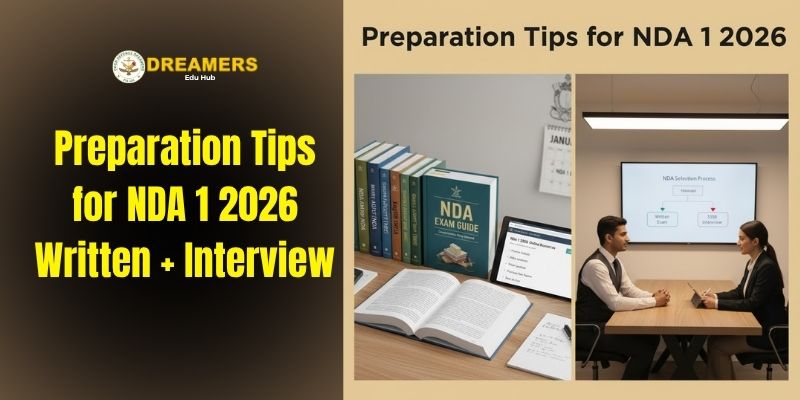If you’re aiming for the NDA this April, you need a calm, finishable plan for both the written exam and the five-day SSB. This guide gives you NDA 1 2026 preparation tips you can use today and, more specifically, preparation tips for nda 1 2026 written + interview that fit a school routine. It focuses on what moves your score: a lean booklist, time-boxed practice, phased revision, and interview drills that build confidence without fluff.
Why this plan works
Most students don’t fail for lack of grit—they fail because the plan is too big. You’ll use a six-day loop, a mistake-first review habit, and short mock sprints to convert effort into marks. The approach keeps your shelf light and your practice heavy, which is the real heart of NDA success.
Exam snapshot in 60 seconds
Written: Mathematics (120 Qs) and GAT (150 Qs) in one day with negative marking.
SSB Interview: screening (OIR + PP&DT), psychology tests, GTO tasks, and personal interview, followed by conference.
Your plan must train speed, accuracy, decision-making under time, and clear communication.
Core principles you will follow daily
Time-boxing: 90 minutes deep work + 10 minutes breathers.
Mistake notebook: start every session by reworking yesterday’s errors.
PYQs first: practice topic-wise, then mixed, so you learn the real patterns.
Formula + flashcard stack: revisit every third day.
Light but consistent current affairs cycles.
These are not generic tips; they are actionable NDA 1 2026 preparation tips. Throughout, we’ll reference preparation tips for nda 1 2026 written + interview to keep both parts—written and interview—connected.
Topic Priority Table (Written + SSB)
| Area | Priority | What to Master | Daily Target | Typical Pitfalls |
|---|---|---|---|---|
| Mathematics | Very High | Algebra, Trigonometry, Coordinate Geometry, Calculus | 60–80 problems | Skipping steps, weak formula recall |
| English | High | Grammar, Vocabulary, Reading Comprehension | 1 editorial + 1 cloze + 1 error set | Guessing idioms, rushing RC |
| GS (Polity/History/Geo/Sci) | High | Constitution basics, modern history timeline, India maps, NCERT science | 2 chapters + 30 min CA | Fact-only learning without context |
| Current Affairs | Medium | Last 6–8 months affairs | 30 minutes | Reading without spaced revision |
| SSB Communication | Very High | Clear narration, structure, listening, group coordination | 10 min mirror talk + 1 story/day | Speaking fast, ignoring team cues |
| GTO Prep | High | Progressive group tasks logic, obstacle approach, brief leadership cues | 15–20 min visualization | Over-talking, no concrete plan |
High-yield booklist (finishable, not endless)
Mathematics: NCERT 9–12 for basics; a compact objective drill book; and your own formula handbook.
English: one grammar reference, one vocabulary builder, and daily editorials.
GS: concise polity/history/geography notes and one monthly digest for current affairs.
Practice: previous year papers from day one—topic-wise first, then mixed.
All of this supports NDA 1 2026 preparation tips and makes preparation tips for nda 1 2026 written + interview realistic rather than overwhelming.
The six-day loop that fits school life
Day 1–3 (Math heavy): mornings for problem sets; evenings for English RC and vocab.
Day 4–5 (GS + mixed): mornings for GS + maps; evenings for Maths mixed drills.
Day 6 (mock + analysis): one full mock (alternating Maths/GAT focus), and a deep review.
Day 7 (light reset): stretch, file notes, plan next cycle.
This rhythm delivers practical NDA 1 2026 preparation tips while honoring preparation tips for nda 1 2026 written + interview.
Phased revision that actually sticks
Phase 1: Concept sweep — fast NCERT re-read, highlight rules/definitions, write one-page chapter summaries.
Phase 2: Drill & speed — timed sets, PYQs re-do, RC under a clock.
Phase 3: Exam polish — fixed-day full mocks, two-pass review of formula + mistake notebooks.
Tie each pass to concrete NDA 1 2026 preparation tips and keep sight of preparation tips for nda 1 2026 written + interview as the north star.
Time management inside the written exam
Mathematics: scan once, mark must-solve, avoid ego-traps (a long calculus question can wait if a short trig question gives sure marks).
GAT: use micro-blocks (e.g., 15-minute RC, 15-minute English rules, then GS clusters).
Bubble OMR in controlled batches so you don’t lose flow or fill errors at the end.
SSB: what really changes selection odds
Screening day: crisp story, clear narration, and attentive participation win. For PP&DT, train a simple four-part story frame: Situation → Problem → Action → Result, under one minute.
In the personal interview, structure answers with a STAR mini-structure (Situation, Task, Action, Result).
Across psych tests, stay consistent; don’t craft “what assessors want to hear,” show who you are at your best. These are realistic NDA 1 2026 preparation tips, directly tied to preparation tips for nda 1 2026 written + interview.
Daily micro-drills (15–25 minutes each)
Narration drill: record a 60–90 second summary of an editorial.
Observation drill: 30 seconds to scan a picture, write 5 crisp observations.
Group drill: practice letting others speak; add one constructive, specific point; conclude clearly.
Leadership drill: propose a plan with steps, resources, timing, fallback.
Calm drill: 5 deep breaths + one positive cue line before any test block.
Weekly Timetable at a Glance (Written + Interview)
| Day | Morning Block (90m) | Evening Block (90m) | Why it works |
|---|---|---|---|
| Mon | Maths Algebra/Trig drills + formula review | English RC + Grammar micros + 15m narration | Pairs hard quant with language recovery |
| Tue | Maths Coordinate/Calculus problem sprints (PYQ-led) | GS Polity + Current Affairs recap | Concept + context; builds cross-topic memory |
| Wed | Full/half mock (Maths focus) + analysis | Light RC + vocab story + SSB observation drill | Midweek diagnostics keep errors visible |
| Thu | GS History/Geography timelines + map work | Maths mixed set + 10m mistake notebook | Alternation prevents fatigue |
| Fri | Maths speed set + flashcards | English cloze + error spotting + mock OMR practice | Bridges accuracy and bubbling |
| Sat | Full mock (GAT focus) + analysis | Interview Q-bank: strengths, failures, responsibilities | Rehearsal under time builds calm |
| Sun | Active rest: planning, file notes, stretching | Short CA revision + visualization for GTO | Reset without losing continuity |
Quick FAQ on NDA 1 2026 preparation tips and preparation tips for nda 1 2026 written + interview
Q: How many mocks per week are enough?
A: Two full-length mocks are optimal for most students. Add one half-length sprint if you can analyze it the same day.
Q: What should I prioritize in the last 15 days?
A: Mistake notebook and formula book. Light mixed mocks. Sleep and hydration. New topics are low ROI now.
Q: How do I balance boards and NDA?
A: Use 90/10: boards in school hours and first evening block; NDA written drills in the morning block. Keep interview micro-drills daily.
Q: What if my spoken English is weak for SSB?
A: Narrate one editorial daily, record, and compress to 60–90 seconds. Focus on structure over fancy words.
Q: Do I need coaching?
A: A consistent peer circle and honest analysis can replace a lot of external help. Coaching is useful if it gives you finishable plans and feedback.
Sample answer frames for the interview (aligned to NDA 1 2026 preparation tips and preparation tips for nda 1 2026 written + interview)
“Tell me about yourself” (90 sec): Past → Present → Plan. One line each on academics, responsibilities, hobbies, and why defence.
“A recent failure” (60 sec): Context → Mistake → What you changed → Measurable outcome.
“Leadership example” (60–90 sec): Situation → Team → Action plan → Result → Learning.
“Current affairs view” (45–60 sec): Fact → Impact → Balanced take → One actionable.
Do & Don’t Cheat Sheet
Do: scan papers, secure sure-shot questions first, and review bubbles in small batches.
Do: keep stories realistic and team-centric in PP&DT and GTO.
Do: log metrics (accuracy %, attempts, topics mastered) every Saturday.
Don’t: start a new book in the last 3 weeks.
Don’t: overtalk in groups; invite silent members and summarize.
Don’t: chase “tricks” over fundamentals; your consistency is the real edge.
15-day finish: land the plane, don’t build a new one
Cut new learning to near-zero. Spend 70% on formula + mistake notebooks, 20% on light mocks, 10% on sleep and nutrition. Rehearse interview answers to expected areas: academics, hobbies, responsibilities, strengths, failures, current affairs. This plain, repeatable closure embodies NDA 1 2026 preparation tips and fulfils the promise of preparation tips for nda 1 2026 written + interview.
Above all, stay loyal to NDA 1 2026 preparation tips; keep a physical card of the phrase on your desk. When doubt creeps in, read preparation tips for nda 1 2026 written + interview out loud once, breathe, and start your next timed block. If a day goes off-track, reopen your checklist titled “NDA 1 2026 preparation tips” and execute the next tiny step. On Sundays, journal three wins and three fixes under the header “preparation tips for nda 1 2026 written + interview”.
One page checklist you can print
Keep the booklist tiny and finishable.
Set a six-day cycle and protect analysis time.
Maintain formula + mistake notebooks; revisit every third day.
Do PYQs topic-wise from the start; then mixed sets.
Fix two mock days weekly with same-day analysis.
For SSB, run narration + observation + group drills daily.
This is your pocket version of NDA 1 2026 preparation tips and the essence of preparation tips for nda 1 2026 written + interview.
Final word
Success isn’t about doing more—it’s about doing what compounds. Keep your plan short, repeatable, and accountable. If you stay loyal to these NDA 1 2026 preparation tips, and come back to the same preparation tips for nda 1 2026 written + interview every morning, the gap between effort and outcome will close.





























